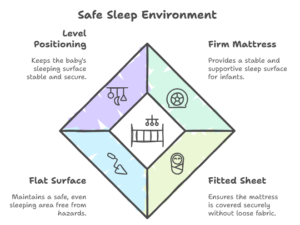Why Won’t My Baby Sleep Through the Night? Common Causes and Solutions
Parents across the globe struggle with babies who won’t sleep through the night. Their family’s well-being and their baby’s development take a hit during this tough phase. Many parents look for ways that work to help their little ones sleep better.
A baby’s normal sleep patterns and common sleep disruptions need proper understanding. Sleep regressions, night feedings, and separation anxiety can turn peaceful nights into challenges. This piece gets into how different growth stages affect a baby’s sleep and why nighttime wakings happen. Parents will find budget-friendly ways to build healthy sleep habits. They’ll learn key ways to create the perfect sleep environment and set up bedtime routines that match their baby’s age. These changes help everyone in the family rest better.
Developmental Factors Affecting Baby’s Sleep
Parents need to understand developmental factors to help their babies sleep through the night. Their growing babies go through most important changes in sleep patterns. These changes affect how well they maintain consistent sleep schedules.
Normal sleep patterns by age
Newborns need by a lot more sleep than older infants and usually require 14-17 hours in a 24-hour period. Babies’ sleep needs change as they develop and grow. The sleep patterns show clear progression through different stages:

Sleep regressions and growth spurts
Babies experience sleep regressions when their sleep patterns change during their most important developmental milestones. Parents should expect these key regression periods:
- 4 months: Sleep patterns mature to become more adult-like
- 8-10 months: Coincides with crawling and pulling up skills
- 12 months: Related to walking and language development
Babies go through about 7-10 growth spurts in their first year. Each growth spurt typically lasts a week. These growth periods often disrupt sleep patterns because babies need more food and sleep than usual.
Circadian rhythm development
A baby’s internal clock, also called circadian rhythm, develops slowly in the early months. Babies don’t produce much melatonin until they reach 1-2 months old. Their melatonin levels become strong enough at 3-4 months to support regular day and night patterns.
Natural daylight exposure and daily routines help babies develop healthy circadian patterns effectively. Babies who breastfeed get extra help from their mother’s melatonin in evening milk. This naturally helps their sleep-wake cycle develop properly.
Your baby’s circadian rhythm development is one of the most important milestones to help them sleep through the night. Most babies can physically sleep for 8 hours without feeding by 6 months. Their sleep patterns might get disrupted temporarily because of separation anxiety and physical milestones.
Parents who understand these developmental changes can set realistic expectations. They can create better sleep strategies based on their baby’s age and stage. Sleep disruptions aren’t problems that need fixing – they’re natural parts of how babies develop. Your baby just needs consistent support and patience.
Common Reasons Babies Wake at Night
Babies wake up at night because of several biological and environmental factors. Parents should understand these patterns to help their babies sleep better. Some nighttime wake-ups are normal and help development, while others need attention to improve sleep quality.
Hunger and feeding needs
Babies wake up at night mainly because they are hungry. This happens more often with younger infants. Newborns and young babies require frequent feeding because their stomachs are small. Most babies can sleep for longer periods by 6 months, though some might still need to feed once or twice at night. Parents can spot real hunger-driven wakings through these signs:
- The baby drinks a complete feed and drifts back to sleep
- Night wakings happen less frequently than daytime feeds
- The baby drinks milk with strong, purposeful swallows instead of short comfort sucks
Discomfort (wet diaper, temperature, etc.)
Physical discomfort disrupts your baby’s sleep patterns frequently. Several common sources cause these disruptions:
- Room temperature variations
- Wet or soiled diapers
- Illness or teething
- Inappropriate clothing
Temperature regulation plays a significant part in your baby’s sleep quality. Your baby becomes restless and wakes up more often at the time temperature changes occur during sleep cycles.
Sleep associations and dependencies
Sleep associations start forming in the early months of life and greatly affect night waking patterns. Babies become more aware of their sleep environment around 3-4 months, and these habits begin to develop. Common dependencies include:
- Rocking to sleep
- Feeding to sleep
- Pacifier use
- Being held
Babies who depend on specific conditions or actions to fall asleep usually need the same help to return to sleep between natural sleep cycles. Their struggle to self-soothe without their preferred sleep association leads to frequent night wakings.
Separation anxiety
Sleep patterns often get disrupted by separation anxiety in babies between 6 months and 2 years old. Your baby’s behavior during this phase shows these signs:
- Crying when parents leave the room
- Difficulty settling at bedtime
- Increased night wakings with calls for parents
- Clinginess and increased fussiness
Babies develop object permanence and understand their parents exist even when they can’t see them. This realization leads to peak anxiety levels. Though this phase challenges both parents and babies, it’s a normal milestone that shows a healthy emotional bond.
Your baby’s separation anxiety might get stronger during big life changes or developmental leaps. You can help your little one through this phase with consistent bedtime routines and empathetic responses while keeping good sleep habits intact.
Creating an Optimal Sleep Environment
The right sleep environment helps babies sleep soundly through the night. A cozy and safe nursery setup helps your baby develop healthy sleep patterns. This thoughtful arrangement of the nursery greatly affects how well your little one rests.
Room Temperature and Lighting
Creating the ideal sleep environment begins with the right temperature control. Research shows that babies sleep best in rooms maintained between 68-72°F (20-22°C). Parents need to check room temperature often since overheating increases SIDS risk.
These simple checks help ensure your baby’s comfort:
- Touch the nape of the neck (not hands or feet)
- Look for sweating or flushing signs
- Add one more clothing layer than what adults wear
Quality sleep depends on proper lighting. Studies show that amber and red lights work best in nurseries because they don’t disrupt melatonin production. Your baby will sleep best in complete darkness. If you need a night light, make sure it is:
- Dim and subtle
- Placed away from the crib
- Red or amber in color spectrum
White noise and Calming Sounds
Research shows white noise works exceptionally well to help babies sleep, as 80% of infants drift off within 5 minutes. White noise helps babies sleep better because it:
- Mimics the womb’s familiar sounds
- Masks the household’s disruptive noises
- Creates consistent sleep patterns
- Reduces crying time and helps babies sleep longer
Parents should play white noise between 50-68 decibels and place the source at least 7 feet from their baby’s sleep area. Continuous, monotonous sounds work better than nature-based or intermittent recordings.
Safe Sleep Practices
A safe sleep environment plays a crucial role in protecting babies from SIDS and other sleep-related incidents. Your baby’s sleep area needs these key features:

Room temperature matters significantly when it comes to safe sleep. Research links environmental temperatures to SIDS risk. A fan can help reduce SIDS risk by moving air around the room, but make sure it doesn’t blow directly on your baby.
Your baby’s crib or bassinet should be in your room, but not in your bed. This setup reduces SIDS risk by up to 50%. Keep the crib close to your bed. This arrangement makes nighttime feeding easier and lets you monitor your baby while maintaining a separate, safe sleep space.
Keep your baby’s sleep environment the same for naps and nighttime sleep. This routine helps build healthy sleep patterns naturally. Never let your baby sleep in car seats, swings, or other sitting devices because these positions can affect their breathing.
Establishing Healthy Sleep Habits
A systematic approach helps create consistent sleep habits that think about the baby’s developmental stage and family circumstances. Babies sleep better with regular bedtime routines. Research proves they fall asleep faster and wake up less during the night.
Consistent bedtime routine
A well-laid-out bedtime routine helps babies understand sleep time approaches. Your routine should last 30-45 minutes and include these essential components:
- Feed (positioned first in routine)
- Bath or gentle cleaning
- Quiet activities (stories, lullabies)
- Final diaper change
- Darkened room placement
Research shows that babies with 3-month-old bedtime routines sleep better and wake up less during the night. Parents can start these routines when their baby reaches six weeks, though strict scheduling becomes important around three months.
Age-appropriate sleep schedule
Sleep needs change substantially during the first year. Here’s a complete guide to age-appropriate sleep needs:

Babies get their longest stretch of sleep early in the night. By three months, many infants can sleep for a 4-5 hour stretch, and this duration increases as they get older.
Teaching self-soothing skills
Self-soothing marks a significant developmental milestone that helps babies unite their night sleep patterns. Parents can help develop this skill through these progressive steps:
- Original Response Delay: A brief pause before responding to minor fussing works best
- Environmental Support: The right room conditions make a difference
- Gradual Independence: The intensity of intervention should decrease with time
Parents should look for their baby’s sleep cues like eye rubbing or decreased activity. These early signals help prevent overtiredness and make the self-soothing process easier.
Gradual night weaning at the right time
A baby’s readiness and your approach determine night weaning success. Babies can stop night feedings around 3-4 months if they maintain healthy weight gain, according to most doctors. Some babies might need night feeds until they’re about 9 months old.
Your night weaning plan will work better if you feed your baby enough during the day. Make each feeding session shorter over time and stick to a bedtime routine that you follow each night. Your baby should also learn to sleep without depending on specific habits.
Babies over 12 months old might handle sudden night weaning well. Younger babies usually respond better to a step-by-step approach.
Teaching your baby to self-soothe often happens alongside independent sleep. Most babies are ready to learn sleep habits between 4-6 months. Parents can tackle both night feeds and sleep patterns together, though each baby develops differently.
Parents should feed their babies fully every 2.5-3.5 hours during daytime to reduce night feeds successfully. This helps babies get enough food and learn to combine their sleep hours at night.
Conclusion
Your baby’s sleep patterns involve a complex mix of developmental stages, physical needs, and environmental factors. Parents who understand age-appropriate sleep patterns and why babies wake up can help their little ones sleep better. Research shows that regular bedtime routines, safe sleep practices, and gradual sleep training lead to better results for families working to combine nighttime sleep.
Every baby develops sleep patterns at their own pace based on growth and personality. You’ll see success when you patiently use the right sleep strategies and create the perfect sleep environment. Your baby needs to be ready for sleep-related changes. Parents who keep their expectations realistic and stick to proven sleep methods help their babies develop good sleep habits. These habits make the whole family’s life better. ## FAQs
Currently, there are no frequently asked questions available related to the article “Why Won’t My Baby Sleep Through the Night? Common Causes and Solutions.” Please check back later for updates or further information.







